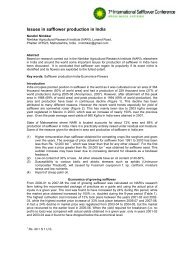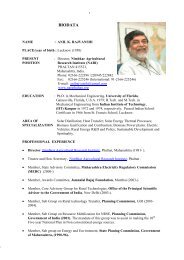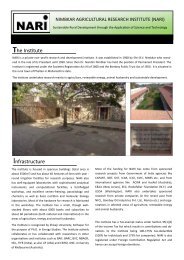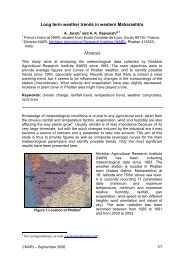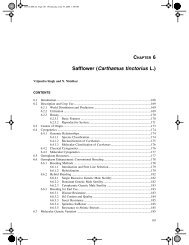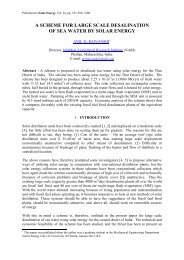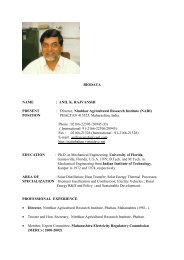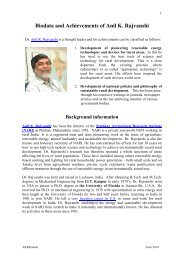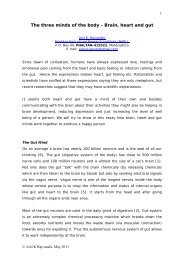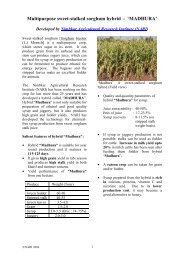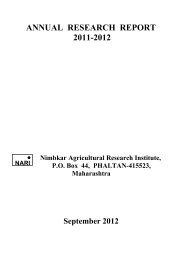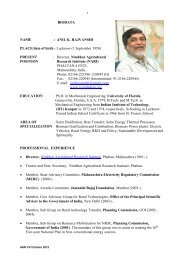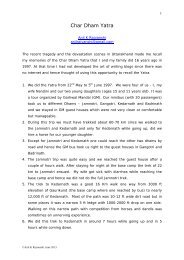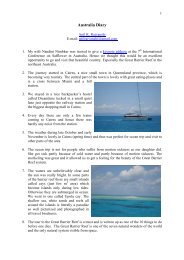Good evening Ladies and Gentlemen, - NARI
Good evening Ladies and Gentlemen, - NARI
Good evening Ladies and Gentlemen, - NARI
You also want an ePaper? Increase the reach of your titles
YUMPU automatically turns print PDFs into web optimized ePapers that Google loves.
1<br />
Energy for Rural Poor – Challenge for Global Community<br />
(A public lecture given at Patel Center in USF, Tampa, Florida on March 21, 2007)<br />
Anil K. Rajvanshi<br />
Director,<br />
Nimbkar Agricultural Research Institute (<strong>NARI</strong>),<br />
P.O. Box 44, PHALTAN-415523, INDIA<br />
E-mail: anilrajvanshi@gmail.com<br />
<strong>Good</strong> <strong>evening</strong> <strong>Ladies</strong> <strong>and</strong> <strong>Gentlemen</strong>,<br />
I am delighted <strong>and</strong> honored to be here to give a talk in the Globalization series at the<br />
prestigious Patel Center.<br />
My talk will be divided into three parts. The first part will be to sensitize you to the<br />
plight of rural poor <strong>and</strong> in the second part we will discuss the technologies that might help in<br />
alleviating their poverty. The last part of my talk will focus on how global community can<br />
participate in lighting up the lives of rural poor.<br />
Since I live <strong>and</strong> work in rural India my talk will be focused on India. However the<br />
methodology developed can be used in any part of the developing world.<br />
Introduction<br />
Just to give you some idea regarding the plight of rural poor in India consider the following:<br />
1) 60% of the rural population or almost 400 million people live in very primitive<br />
conditions 1 . They have no electricity <strong>and</strong> their lives are in darkness. They use<br />
inefficient kerosene lanterns for light <strong>and</strong> primitive <strong>and</strong> ancient biomass cook stoves<br />
for cooking. Modern technology somehow has not touched their lives. Besides, the<br />
poor quality of these devices creates tremendous household pollution. Thus there<br />
are estimates that around 300,000 deaths every year are attributable to inhaling<br />
smoke from these inefficient <strong>and</strong> primitive stoves 2 .<br />
2) Around 54% of India’s population is below 25 years of age <strong>and</strong> most of them live in<br />
rural areas <strong>and</strong> are unemployed. Creation of rural based enterprises is the best way
2<br />
to create wealth, improve their quality of life <strong>and</strong> bring these people into mainstream<br />
of development. Our national leaders are talking about making India the third biggest<br />
economy by the year 2012. Unless the lives of this population is improved this will<br />
not be possible. The so-called “India poised” slogan which the western <strong>and</strong> Indian<br />
English media harp on is not reflected in the lives of the rural population.<br />
3) There is tremendous poverty in rural areas. According to World Bank estimates<br />
around 3 billion people live on less than 2 dollars per day 3 . In India alone there are<br />
around 260 million people or 1/4 th of the population who live on one dollar per day or<br />
less 4 . Except for barely filling their stomach this much money allows them neither the<br />
acquisition of material goods like utensils <strong>and</strong> clothes nor to get any quality products<br />
like light or decent cooking fuel. These low wages also prompt rural poor to have a<br />
large family so that each member can earn one dollar per day <strong>and</strong> increase the daily<br />
family income.<br />
4) Because of poverty there are continuous suicides of farmers. In the last 10 years<br />
about 100,000 farmers have committed suicide<br />
5 . This is according to the<br />
government figures. I am sure the actual figures are much higher. Farming is<br />
presently non-remunerative. This is partly because of the policy of low support price<br />
for farm produce by the Government of India which is the biggest buyer of agricultural<br />
commodities. Secondly, increased aspirations of farmers to improve their quality of<br />
life has made them get into a never ending debt of loan sharks. Thus no amount of<br />
soft financial packages will prevent the farmers’ suicides or help the marginal<br />
farmers. These are all short-term solutions. There is an old Chinese saying “You can<br />
feed a person for a short time by supplying him fish, but if you teach him how to catch<br />
fish he will feed himself the rest of his life”. Thus there is a need to create a long<br />
term agricultural policy which brings in wealth to the countryside without much<br />
government support. This will automatically improve the farmers’ lot.
3<br />
5) There is a serious energy crisis in rural India. In various states there is a tremendous<br />
shortage of electricity. For example, per capita consumption of electricity in rural<br />
areas is only 250 kWh/yr or about 2% that in U.S. 6<br />
As we all know without electricity<br />
very little development can take place <strong>and</strong> this is reflected in these areas. In my state<br />
of Maharashtra which is one of the most industrialized states of India, about 5000<br />
MW peak shortfall exists 7 . Blackouts <strong>and</strong> brownouts is a regular feature of daily life.<br />
In rural Maharashtra where I live, around 12-15 hours of daily blackout takes place.<br />
This has created havoc in the lives of people. Besides it has spawned a whole<br />
industry of small <strong>and</strong> inefficient fossil-powered electric gensets of 1-10 KVA capacity<br />
which produce huge pollution in rural areas.<br />
6) Last year India imported about 45 billion dollars worth of petroleum products. With<br />
ever increasing price of crude this number will increase in coming years <strong>and</strong> will put a<br />
heavy burden on balance of payment account 8 . Besides the uncertainty of supply<br />
from various countries can play havoc with the energy security of India.<br />
I feel most of these problems have come because of non-governance. In a corrupt society<br />
which unfortunately India is, the first casualty is governance <strong>and</strong> we are seeing the effects.<br />
Part of this non-governance has been a very poor energy planning which has resulted in<br />
unavailability of adequate energy in rural areas.<br />
Energy is the basis of life. All other activities flow from it. Therefore availability of<br />
affordable energy in rural areas is the only way to improve the quality of life of its inhabitants.<br />
I believe that one of the best solutions to the above problems is energy production<br />
via agriculture <strong>and</strong> the development of high technology devices to provide the basic needs of<br />
cooking, lighting <strong>and</strong> clean water to rural areas. Energy production via agriculture can<br />
produce rural wealth by providing energy, creating employment, increasing wages <strong>and</strong><br />
providing services to improve people’s quality of life. In the development of a viable energy<br />
technology <strong>and</strong> in producing devices, the role of global technological community becomes<br />
important <strong>and</strong> I will discuss in detail what they can do.
4<br />
Production of Energy<br />
Three types of fuels can be produced easily via agriculture. Liquid fuels such as<br />
ethanol, pyrolysis oil, or biodiesel; gaseous fuels like methane; <strong>and</strong> production of electricity.<br />
Though the basic technology for their production exists, much more R&D is needed for<br />
increasing their efficiency <strong>and</strong> making them affordable. This is the challenge for global<br />
technological community.<br />
Ethanol fuel can easily be produced from agricultural crops like sweet sorghum,<br />
sugarbeet, sugarcane, corn etc., However to produce it in an affordable <strong>and</strong> environmentally<br />
sound manner will require tremendous inputs of biotechnology <strong>and</strong> good engineering. Thus<br />
research is being done in US <strong>and</strong> all over the world in converting agricultural residues into<br />
ethanol via the enzymatic hydrolysis process.<br />
Similarly biodiesel can be produced from a horde of oil producing crops like Jatropha,<br />
Soybean, Pongamia, Castor etc. Though the production of biodiesel is quite easy, there is a<br />
need to increase the yield of oil bearing plants <strong>and</strong> to develop internal combustion engines<br />
which can run on a whole bouquet of the biodiesel. Presently the high speed diesel engines<br />
require tailored biodiesel.<br />
The pyrolysis oil on the other h<strong>and</strong> is produced by rapid combustion of biomass <strong>and</strong><br />
then condensing rapidly the ensuing vapors or smoke to yield oil which is nearly equivalent<br />
to diesel. Pyrolysis oil still requires much more R&D in terms of producing it economically,<br />
improving its keeping quality <strong>and</strong> making it suitable for use in existing internal combustion<br />
engines. Nevertheless recent experiments in Sweden on running a 5 MW diesel power plant<br />
on pyrolysis oil have been successful 9 .<br />
In any agriculture only 25-40% of the produce is food. Rest 60-75% forms the<br />
agricultural residues. It is these residues which can produce electricity via biomass-based<br />
power plants or pyrolysis oil or ethanol fuel. Any marginal farm can produce agricultural<br />
residues even if the main food crop fails. Our calculations show that on an average a farmer<br />
in India can get an extra income of $ 200-300/acre per year from the residues alone if they
5<br />
are used for producing energy 10 . This income can give him benefits even in case of a<br />
distress sale of his crop. Farmer is a multipurpose industrialist producing a variety of outputs<br />
from the same piece of l<strong>and</strong>. We do not know of any other industry which can exist or can<br />
survive selling only 25-40% of its produce with the rest being wasted. So why the farming<br />
should be treated differently. Thus unless <strong>and</strong> until the farmer gets remuneration for his<br />
entire produce, farming will never become economically viable.<br />
About 600 million tons of agricultural residues are produced annually in India 11 .<br />
Most of these residues are burnt in the fields as a solution to the waste disposal problem.<br />
This not only wastes the precious biomass resource but also produces tremendous air<br />
pollution.<br />
Theoretically these residues can produce about 80,000 MW of electric power year<br />
round through biomass based power plants. This power is nearly 50% of total installed<br />
capacity of India. Alternatively they can produce 156 billion liters of ethanol which can take<br />
care of 42% of India’s oil dem<strong>and</strong> for year 2012. Similarly the residues can also produce<br />
about 400 billion kg of pyrolysis oil which is equivalent to 80% of total Indian oil dem<strong>and</strong> for<br />
2012. Thus the agricultural residues if properly utilized can take care of a huge chunk of<br />
India’s energy needs.<br />
A part of these agricultural residues can also be used via the bio-digester route to<br />
produce fertilizer for the crops <strong>and</strong> methane gas to either run rural transport, irrigation pump<br />
sets or for cooking purposes. Another stream can also be used for producing fodder for<br />
animals. Thus the residues can produce fuel, fodder <strong>and</strong> fertilizer. Which stream of residue<br />
conversion technology is eventually followed will depend upon the existing market forces.<br />
The production of electricity in India via residues or the use of wood from fast<br />
growing tree species will require an investment of about 35 billion dollars 12 . However it will<br />
bring about 10 times more money to rural areas in terms of revenues from electricity<br />
generation. Besides it can potentially create almost 120 million extra jobs in these areas 12 .
6<br />
As the industrial dem<strong>and</strong> for fuels <strong>and</strong> electricity increases, we might see large tracts<br />
of farml<strong>and</strong> coming under fuel crops <strong>and</strong> food production may suffer. People who have cars<br />
have money <strong>and</strong> when they give good money for the homegrown fuel the farmers will put<br />
majority of their l<strong>and</strong> under fuel crops. This is already happening in India <strong>and</strong> will happen in<br />
almost any country including U.S. Thus there is a need to seriously debate the food vs. fuel<br />
issues.<br />
Consequently R&D needs to be done on crops which produce both fuel <strong>and</strong> food<br />
from the same piece of l<strong>and</strong>. Sweet sorghum is one such crop. Our Institute <strong>NARI</strong> has<br />
pioneered the development of this crop in India 13 . We introduced it in the country in early<br />
1970s. Sweet sorghum produces food (grain) from its earhead, fuel from its stem (the sweet<br />
juice can be fermented to produce ethanol) <strong>and</strong> bagasse <strong>and</strong> leaves make an excellent<br />
fodder for animals. Alternatively they can also be used as fuel in power plants. Sweet<br />
sorghum is a thrifty crop <strong>and</strong> produces maximum sugar per unit of water of any crop known<br />
to man. Presently our hybrid MADHURA produces 2000 – 3000 l/ha of ethanol per year. It is<br />
presently planted in large areas of India <strong>and</strong> has been exported to various countries<br />
including US.<br />
Similarly if the agricultural residues can be broken down by suitable enzymes to<br />
produce ethanol then both food <strong>and</strong> fuel can be produced from all food crops. Extensive<br />
research in this field is being done by universities <strong>and</strong> industry world over <strong>and</strong> this<br />
technology will be very useful for rural areas of the world 14 .<br />
I strongly feel that when the farmers are forgotten the long term sustainability of the<br />
country is threatened. When farms produce both food <strong>and</strong> fuel then their utility becomes<br />
manifold.<br />
Now with the ethanol <strong>and</strong> biodiesel programs taking shape in U.S., I feel it will<br />
again become a l<strong>and</strong> of farmers. In India 65% of its population depends upon farming <strong>and</strong><br />
with energy from agriculture as a major focus India has the potential of becoming a high tech<br />
farming community.
7<br />
Water Issues<br />
However for farming to increase so that it can take the load of food <strong>and</strong> energy<br />
production, adequate water supply has to be assured. To my mind supply of adequate water<br />
to poor regions of the world is a much bigger challenge then even energy availability <strong>and</strong><br />
where the global technological community can play an important role. Not only is there a<br />
water shortage but lack of clean potable water results in millions of deaths every year due to<br />
diarrhea.<br />
With green revolution in India there has been an extensive use of water resulting in<br />
shortage in some parts of the country. This is despite the fact that there is enough rainfall.<br />
Every year India receives ~ 4000 billion cubic meter of rainfall whereas the present yearly<br />
water consumption is only 650 billion cubic meter or 16% of total rainfall. Thus theoretically<br />
we have enough water, but the rainfall is not evenly distributed over India <strong>and</strong> it comes in<br />
short spells thereby pointing to the need for rainwater harvesting <strong>and</strong> storage programs.<br />
However the issues of rainwater harvesting <strong>and</strong> its supply to the community in rural<br />
areas raise a question of who will own the water bodies. This is a touchy issue <strong>and</strong> quite a<br />
few developing countries are grappling with it. I feel there is a need for the local<br />
governments to develop policies so that rural water utilities can be set up which can harvest<br />
the rain, store it <strong>and</strong> then supply this water to a village throughout the year. These water<br />
utilities may also be able to buy water from the government through the existing canal<br />
system. Presently all the water utilities in India are owned by the government <strong>and</strong> this leads<br />
to corruption in supply of water <strong>and</strong> its very inefficient usage. In 2003 Government of India<br />
passed an electricity act allowing for the first time the private players to produce, sell <strong>and</strong><br />
distribute electricity anywhere in the country. This act has allowed power producers to break<br />
free from the clutches of inefficient <strong>and</strong> corrupt government power utilities. I feel a similar<br />
water act will help in supply of water to rural areas.<br />
Two most important issues for rural development are supply of clean water <strong>and</strong><br />
electricity. <strong>NARI</strong> has developed a strategy whereby it is shown that a microutility producing<br />
500 kW power for rural areas can easily use the heat of the flue gases of the engine to boil
8<br />
or distil water to make it potable 15 . The 500 kW power plant is sufficient for a village of 2000-<br />
3000 people. The combined cycle of electricity <strong>and</strong> water production will increase the<br />
efficiency of the power plant to almost 65-70% from the existing low of 35%. Nevertheless<br />
R&D is needed in improving the distillation process <strong>and</strong> developing a compact water<br />
treatment plant so that the potable water can be delivered at affordable price.<br />
Development of Efficient Energy Devices<br />
Rural population has the same aspirations as you <strong>and</strong> I have. With increased<br />
exposure to mass media their desire to improve their lot has also increased. Thus<br />
technology intervention is required in using local resources to provide products <strong>and</strong> services<br />
to these people. Filtering down approach of urban goods to rural areas will not work in the<br />
long run because of lack of infrastructure, resources <strong>and</strong> different local situations.<br />
This is a technological age. Whatever we do is governed by technology <strong>and</strong> thus<br />
technology plays an extremely important role in our lives.<br />
Most of the technological efforts in the past for providing basic facilities to rural areas<br />
have been based on a “tinkering” approach, meaning a small adjustment here <strong>and</strong> there,<br />
<strong>and</strong> using “low” or appropriate technology. This approach, which has been used by various<br />
agencies, normally resulted in incremental changes like development of improved chulhas<br />
(cook stoves) or better bullock carts. Tinkering, however, has barely made a dent in the<br />
quality of life of poor people. And often, the introductions of these technologies brought other<br />
problems such as increased workloads for women.<br />
I therefore believe that sophisticated – or “high” – technology is needed to convert<br />
efficiently the locally available resources <strong>and</strong> materials into useful products. This is the<br />
hallmark of evolution where natural systems evolve into very efficient materials <strong>and</strong> energy<br />
converters. In this process, size reduction <strong>and</strong> increased complexity of system takes<br />
place 15 . Some of our designs <strong>and</strong> technologies are following the size reduction route. For<br />
example, computer chips, cell phones, power plants, etc. have reduced in size, increased in<br />
complexity <strong>and</strong> become more efficient. Technology developers should follow this strategy in<br />
developing rural technologies. In fact, much more sophisticated thought <strong>and</strong> “high”
9<br />
technology is required for solving rural problems since the materials <strong>and</strong> energy resources<br />
available are limited <strong>and</strong> often in “dilute forms”. Thus the strategy of high technology allows<br />
maximum energy <strong>and</strong> materials to be extracted for useful end products.<br />
I will now show you few examples where high technology intervention can provide a<br />
quantum jump in the quality of life of rural population. These examples are for lighting <strong>and</strong><br />
cooking since they constitute 75% of total energy used in rural households.<br />
Strategy for lighting<br />
The history of civilization is the history of lighting. Lighting allowed mankind to<br />
extend daylight hours <strong>and</strong> hence increase productivity <strong>and</strong> commerce. It is a sad state of<br />
affairs in India that nearly 60 years after independence around 60% of the rural population<br />
are without electricity. They use a simple but very inefficient hurricane kerosene lantern for<br />
lighting. Similar is the story of rural poor in other parts of the world. For example in some<br />
parts of Africa around 80% of rural population has no electricity.<br />
Our Institute <strong>NARI</strong> has therefore developed a very efficient lantern called Noorie 16 .<br />
This lantern produces about 1350 lumens (lm) of light which is equivalent to that from a 100<br />
W electric bulb <strong>and</strong> runs either on kerosene, diesel or with slight modification on low<br />
concentration ethanol. It is reasonably priced at US$ 10, is very light weight, efficient <strong>and</strong><br />
also doubles up as a cooking device.<br />
However in developing the lantern we became aware that the stumbling block in<br />
improving its efficiency was the thermoluminescent (T/L) mantle which is what produces<br />
light. Presently these T/L mantles have an efficacy of 2-3 lm/W. In comparison a 100 W<br />
light bulb has an efficacy of 10-13 lm/W <strong>and</strong> a compact fluorescent lamp (CFL) ~ 50-70<br />
lm/W. If by R&D we can match the mantle efficacy with that of a light bulb then the liquid<br />
fuel lighting can become better than the electricity-based lighting. How can this happen<br />
Consider the power plant-to-light efficiency (PPL) or the amount of energy that you<br />
finally get in your household socket. The PPL of CFL is only 10-14 lm/W or nearly that of<br />
light bulb. This is so since 70% of the energy from the thermal power plant is lost as heat
10<br />
<strong>and</strong> further 30-33% energy loss takes place in transmission <strong>and</strong> distribution (T&D). The T&D<br />
losses in developing countries are high because of electricity theft. Thus only 20% of total<br />
fuel energy is available as electricity in the household socket. Research in producing better<br />
T/L mantles therefore can provide very efficient decentralized liquid fuel lighting.<br />
These T/L mantles have not changed since early 1860s when Welshbach in<br />
Germany made them out of radioactive Thoria/Ceria mixture. Many people have tried to<br />
improve them but have not succeeded. We still do not underst<strong>and</strong> how the light is produced<br />
from this mixture. For example the 1500-2000 0 C flame produces light as if it is coming from<br />
a 3600 0 C black body. I feel that the emerging field of nanoscience can help in developing<br />
materials, which can glow efficiently even at low temperatures of 1000-1500 0 C. Besides<br />
R&D is necessary in making these mantles out of sturdier materials like carbon composites,<br />
ceramic-based thermoluminescent materials etc. Presently these mantles are very fragile<br />
<strong>and</strong> break easily.<br />
Ultimately for decentralized light based on chemical fuels we should try to copy the<br />
bioluminescence mechanism of a firefly where visible light is produced very efficiently <strong>and</strong> at<br />
room temperatures. Similarly it is possible that mankind one day will develop a strategy<br />
where sunlight will photo catalyze two liquids which when mixed together will produce<br />
brilliant light. The time is now to work on this strategy <strong>and</strong> that is the challenge for global<br />
community. With grid electricity still a distant dream for a major portion of rural areas,<br />
efficient liquid fuel lighting needs to be encouraged.<br />
Simultaneously we have to continue exploring decentralized, electricity-based<br />
lighting, since 100 years of R&D has gone in perfecting it.<br />
We at <strong>NARI</strong> pioneered the strategy of biomass based power plants for providing<br />
energy self-sufficiency at taluka level 12 . Taluka is an administrative block in India consisting<br />
of a town <strong>and</strong> about 100 contiguous villages <strong>and</strong> is equivalent to a county in U.S both in<br />
terms of l<strong>and</strong> area <strong>and</strong> population. The taluka strategy was based on producing power from<br />
agricultural residues <strong>and</strong> wood from fast growing trees. Thus the biomass available in a<br />
taluka could easily support two 15 MW biomass based power plants. This strategy became a
11<br />
national policy <strong>and</strong> was implemented by the Government of India from 1996 till 2002.<br />
Consequently 40-50 biomass-based plants of 6-10 MW capacity each were set up in<br />
different talukas, but the whole program had a mixed success. This was because the<br />
Electricity Act of 2003 had not come into being. With the advent of this act there are<br />
indications that there will be an explosive growth of such biomass power plants all over the<br />
country.<br />
In the range of 10-500 kW power, R&D is needed in biomass gasifier-based plants,<br />
steam engines, sterling engines or biogas-based gas turbines. There is a whole array of<br />
technologies to be developed so that power is generated from renewable fuels, which are<br />
biomass-based, environment-friendly <strong>and</strong> produced locally. This is the challenge for global<br />
community.<br />
On micro scale in the range of 10-20 W there are exciting possibilities for lighting.<br />
For example there are tantalizing indications that new class of materials are being<br />
researched which can produce 3 electrons per photon thereby providing a quantum jump in<br />
the efficiency of solar cells 17 . These type of solar cells together with ultra capacitor batteries<br />
(instead of regular lead-acid batteries) can revolutionize rural lighting.<br />
Similarly there has been a quantum jump in the efficiency of thermoelectric elements<br />
– a device which converts heat directly into electricity 18 . These elements can be<br />
incorporated into any biomass cook stoves <strong>and</strong> about 40-50 W of power can be produced.<br />
This power is enough to run a small fan so that the combustion efficiency of the cook stove<br />
is nearly doubled <strong>and</strong> part of the power can be stored in ultra capacitors for lighting. We<br />
recommended such a strategy about 4 years back <strong>and</strong> are delighted to inform you that<br />
Philips last year has produced such a stove.<br />
Work is also going on in US in producing 10-20 W micro engines 19 . These engines<br />
can run on ethanol or methanol <strong>and</strong> hence can eliminate the need for heavy storage<br />
batteries since the energy is stored in the fuel. Thus an extremely efficient, compact <strong>and</strong> light<br />
weight decentralized lighting system can be thought of which consists of a micro engine<br />
powering a light emitting diode (LED) or CFL lamps.
12<br />
Cooking energy strategy<br />
Only liquid <strong>and</strong> gaseous fuels produced renewably can provide clean cooking<br />
energy. Two fuels fall into this category. Liquid fuels like ethanol or biodiesel <strong>and</strong> gaseous<br />
fuel like biogas.<br />
Ethanol is an excellent fuel for cooking. At <strong>NARI</strong> we have developed a stove which<br />
runs on 50% ethanol-water mixture 20 . This mixture is very safe <strong>and</strong> can be easily distilled in<br />
a backyard still with much less energy than that required to distil high concentration of<br />
ethanol. The stove has a maximum thermal capacity of 2.5-3 kW <strong>and</strong> has a flame control for<br />
simmer <strong>and</strong> high settings so that it works just like an LPG stove. Large scale testing in the<br />
field has been very positive <strong>and</strong> almost all the rural women who have tried it compare it very<br />
favorably with an LPG stove. However in order that ethanol can be used as a rural<br />
household fuel, the presently tough excise laws have to be modified. Our Noorie lantern also<br />
works on 50% ethanol-water mixture. Thus we have developed high tech, environmentally<br />
sound cooking <strong>and</strong> lighting systems which can run on homegrown fuel.<br />
Biodiesel is another fuel which can be grown locally. Various governments all over<br />
the world are embarking on a major program of using biodiesel for running automobiles.<br />
However R&D is required in improving its yield per ha <strong>and</strong> also its use in cooking stoves.<br />
Presently there are no reliable cooking <strong>and</strong> lighting devices which can run on biodiesel.<br />
A clean gaseous fuel that can be produced from the existing biomass sources is<br />
biogas. Biogas has been used extensively in rural areas of India. However it is produced<br />
very inefficiently in fixed <strong>and</strong> floating dome systems as shown in the slide <strong>and</strong> requires<br />
considerable amount of cowdung <strong>and</strong> other nitrogenous material. It is not suitable for a<br />
household with less than 3-4 cattle. Besides there are problems of gas production during<br />
winter <strong>and</strong> improper mixing of mixed inputs like biomass, night soil, cowdung, etc. The<br />
biogas which is a mixture of methane <strong>and</strong> carbon dioxide cannot be liquefied <strong>and</strong> requires<br />
very high pressure of more than 100 atmospheres to compress it so that it can be used over<br />
extended periods.
13<br />
Thus R&D is necessary in two areas. One is in the development of extremely<br />
efficient biogas reactors so that the production per unit of biomass inputs could be<br />
maximized. The second area is to develop appropriate storage materials which could store<br />
biogas at medium pressures.<br />
Research is also being done world over in methane storage <strong>and</strong> recently<br />
experiments have been conducted in storing it at medium pressures of less than 40<br />
atmospheres in hydrates, porous carbon <strong>and</strong> porous organic structures 21 . There is thus a<br />
need to develop low cost storage materials so that biogas could be stored in them for usage<br />
in households. New materials developed through nanoscience <strong>and</strong> nanotechnology can be<br />
used for this purpose. Thus a scenario can be thought of where a micro-utility company in<br />
rural areas will buy locally available raw materials like cowdung, biomass, etc. <strong>and</strong> will use<br />
them in a very high tech biogas reactor to generate biogas efficiently. This gas can be<br />
stored in small cylinders lined with gas-absorbent materials <strong>and</strong> transported to households<br />
just like the present LPG cylinders. This will revolutionize the cooking system in rural India<br />
<strong>and</strong> other parts of the world.<br />
Optimization of biogas production from a reactor requires sophisticated electronics<br />
based controls <strong>and</strong> biochemical engineering technology. A small utility can afford to do it<br />
whereas for a household it might be too costly. Tinkering around with existing biogas<br />
reactors will not solve the problem. A very sophisticated science <strong>and</strong> technology input has<br />
to be brought to bear on the problem for optimizing the biogas production in rural areas.<br />
The use of high technology in lighting <strong>and</strong> cooking energy can result in considerable<br />
economic development in rural areas. Our estimates show that this energy industry both for<br />
fuel <strong>and</strong> device production can be of the order of 10 billion dollars per year in India alone 21 .<br />
Since the fuel production will be rural-based, it can bring in substantial wealth to these areas<br />
both in terms of biomass production <strong>and</strong> also in processing it to produce the fuel.<br />
I hope these examples have given you a feel for the need of using very sophisticated<br />
technology for solving the rural problems.
14<br />
Now I will come to the last part of my talk namely how the global community can<br />
participate in the development outlined above <br />
Role of Global Community<br />
There are two ways in which the global community can help in improving the lives of<br />
rural poor round the world. One is by providing liberally the technologies, knowledge,<br />
intellectual property, funds etc, on extremely soft terms <strong>and</strong> secondly by putting their own<br />
house in order. I will discuss these in details below.<br />
In recent years many rural development experts especially C. K. Prahalad of<br />
University of Michigan has talked about the bottom of pyramid approach to development 22 .<br />
They contend that helping the rural poor makes good business sense <strong>and</strong> the example of<br />
Mohammad Yunus who last year won the Noble Peace Prize for his micro credit work in<br />
Bangladesh attests to that. What Prahalad says makes sense since we saw that the energy<br />
industry for rural areas in India could be of the order of 10-20 billion dollars per year <strong>and</strong> that<br />
empowering the rural poor to produce energy through agriculture could improve their lot.<br />
However, I feel that we should look beyond the issues of business <strong>and</strong> getting financial gains<br />
from rural poor.<br />
In this era of globalization the whole world is one global village where the actions of<br />
one part directly affect those of others. Thus global warming, environmental pollution <strong>and</strong> the<br />
migration of large number of people from one country to another for better opportunities are<br />
all a result of globalization process.<br />
One of the impacts of globalization has been the rise of international terrorism. In<br />
fact poverty breeds terrorism which ultimately affects all of us. It is therefore in the interest of<br />
North to help the South so that wealth is created in its rural areas <strong>and</strong> poverty removed. This<br />
can happen when North, which has the resources to produce new ideas, technologies <strong>and</strong><br />
financial instruments, uses them for providing services to rural areas as outlined above. In<br />
this process the U.S. universities, corporations <strong>and</strong> businesses will need to work with<br />
developing country NGOs <strong>and</strong> businesses in a meaningful <strong>and</strong> cooperative relationship. I
15<br />
also feel that the governments of both North <strong>and</strong> South should have a minimal role in such<br />
ventures.<br />
The second way in which the global community especially those in the North can<br />
help the world is by reducing their consumptive life style. North especially US is the role<br />
model of the world. The citizens of the world try to copy the U.S. life style, even though it is<br />
totally unsustainable. For example if every citizen of this earth follows it then we will need<br />
the resources of 4 earths to sustain it 23 . Some recent reports have shown that last year<br />
there were 1 billion obese people (mostly in developed world) as against 600 million<br />
malnourished ones in developing world 24 . For global sustainability this consumptive life<br />
style has to change. In this age of instantaneous communication whatever happens in New<br />
York, London or Paris is immediately copied by the elite of developing world. Hence if North<br />
shows the way towards sustainability then it will have a great impact on the rest of the world.<br />
Every citizen of this earth aspires to a decent life style. I believe such a life style is<br />
possible in much less energy than is consumed by an average U.S. citizen. For example in<br />
U.S. the per capita energy consumption is 350 GJ/yr whereas in India it is a low of 10 GJ/yr<br />
25 . I feel energy consumption of 50-70 GJ/person/yr or 1/5 th that of US can provide a very<br />
decent <strong>and</strong> emotionally satisfying life style 26 . This type of energy consumption will put much<br />
less pressure on earth’s resources besides reducing substantially the environmental<br />
pollution. However it can only happen if we follow the maxim of “simple living <strong>and</strong> high<br />
thinking”. This is the genesis of spirituality which helps us become internally secure <strong>and</strong> less<br />
greedy for materials <strong>and</strong> resources 27 .<br />
To my mind the highest spiritual work for mankind is to help poor people improve<br />
their quality of life. As engineers <strong>and</strong> scientists we can do it by providing right-sized<br />
technologies at the right “price” to the poor. It is a doable goal. What is needed is the<br />
direction <strong>and</strong> will of leaders in both North <strong>and</strong> South to make the life of poor people better.<br />
Once our basic needs are satisfied, all of us long for some meaningful existence.<br />
Even very rich are looking for some meaningful actions <strong>and</strong> purpose in their life. Happiness<br />
cannot be obtained by money alone. It only comes when there is some meaning to the life.
16<br />
That meaning, I feel comes from helping other less fortunate people <strong>and</strong> by giving back<br />
something to the society. I believe that the whole purpose of our existence is to increase<br />
personal <strong>and</strong> societal infrastructure. Personal infrastructure includes our health, happiness<br />
<strong>and</strong> general well being. By improving our personal “infrastructure” we become better human<br />
beings <strong>and</strong> it helps in our emotional growth <strong>and</strong> evolution. By giving back to the society so<br />
that its “infrastructure” increases we help in mankind’s evolution. Both these activities when<br />
carried out simultaneously can give us a great joy <strong>and</strong> satisfaction.<br />
Finally I would like to point out that rural population of the world has a great strength<br />
of being satisfied with fewer material comforts. Partially this is because they never had many<br />
material goods in the first place <strong>and</strong> partly because they have not been corrupted by the so<br />
called notions of “good life”. Thus I believe that the provision of high technology for meeting<br />
the basic needs of rural poor together with their spiritual strength may provide a new model<br />
of sustainable development <strong>and</strong> in the process may teach North a lesson or two in<br />
sustainability.<br />
I will end my talk by telling you an Indian story, a tale from our ancient scriptures, the<br />
Puranas 28 . It is a typical Indian story of a sage <strong>and</strong> his disciples. The sage asks his<br />
disciples, “When does the night end” And the disciples say, “at dawn, of course.” The<br />
sage says, “I know that. But when does the night end <strong>and</strong> the dawn begin” The first<br />
disciple, who is from the tropical south of India which is similar to South Florida replies:<br />
“When the first glimmer of light across the sky reveals the fronds on the coconut trees<br />
swaying in the breeze, that is when the night ends <strong>and</strong> the dawn begins”. The sage says<br />
“no,” so the second disciple, who is from the cold north, ventures: “When the first streaks of<br />
sunshine make the snow gleam white on the mountaintops of the Himalayas, that is when<br />
the night ends <strong>and</strong> the dawn begins.” The sage says, “no, my sons. When two travelers<br />
from opposite ends of our l<strong>and</strong> meet <strong>and</strong> embrace each other as brothers, <strong>and</strong> when they<br />
realize they sleep under the same sky, see the same stars <strong>and</strong> dream the same dreams -<br />
that is when the night ends <strong>and</strong> the dawn begins.” I feel that when the citizens from North
17<br />
light up the lives of residents of South through technology <strong>and</strong> resources then it will bring in<br />
the dawn of a new age for the civilization <strong>and</strong> promote global harmony.<br />
Thank you very much.<br />
References<br />
1. Rural Energy – India country gateway;<br />
www.incg.org.in/countryGateway/RuralEnergy/Overview/Ruralenergy.in/ India.htm<br />
2. ITDG. Smoke – the killer in kitchen; www.itdg.org/html/smoke/smoke_ report _ 1.htm.<br />
3. World Bank. Overview of World Poverty. www.worldbank.org/poverty.<br />
4. IFAD. Rural Poverty in India, 2007. www.ruralpovertyportal.org/english/<br />
regions/asia/ind/index.htm.<br />
5. S. Narain. Why do farmers have to die Down to Earth, Center for Science <strong>and</strong><br />
Environment, New Delhi. June 15, 2006.<br />
6. Planning Commission. Draft Report of the Expert Committee on Integrated Energy<br />
Policy. Govt. of India. December 2005. pg. 1.<br />
7. No power cuts for now but user curbs on. News item in Indian Express. April 5, 2007.<br />
8. India’s oil import bill shoots to $ 44.64 bn. http://US.rediff.com/money/2006/may/10<br />
oil.htm q=bp&file.htm.<br />
9. Solantausta, Y. et. al., Use of pyrolysis oil in test diesel engine to study the feasibility of<br />
diesel power plant. Biomass Bioenergy, 1994, 7, 297-306.<br />
10. Rajvanshi, A. K. Agriculture Policy for Energy Security. http://nariphaltan.virtualave.<br />
net/agri.htm.<br />
11. K. S. Jagdish. Bioenergy for India: Prospects, problems <strong>and</strong> tasks. Energy for<br />
Sustainable Development. 2003, Vol. VII No. 1. pp. 28-34.<br />
12. Rajvanshi, A. K., Talukas can provide critical mass for India’s sustainable development.<br />
Curr. Sci., 2002, 82, 632-637.<br />
13. Rajvanshi, A. K. et. al., Sweet Sorghum R&D at <strong>NARI</strong>. http://nariphaltan.virtualave.<br />
net/sorghum.htm.<br />
14. Commercial-scale wood-based ethanol production begins in Japan.<br />
www.japanfs.org/db/ 1674-e. 28 March 2007.<br />
15. Rajvanshi, A. K., Strategy for Rural Electrification. REPSOVISION, Vol. 33, January-<br />
March, 2006. Winrock International, New Delhi.
18<br />
16. Rajvanshi, A. K. 1989. Development of Improved Lanterns for Rural Areas. http://<br />
nariphaltan.virtualave.net/lantern.htm.<br />
17. Basic Research Needs for Solar Energy Utilization. Workshop Report, Office of Science,<br />
U. S. Dept. of Energy April 18-21, 2005. pg. 235. www. sc.doe.gov/bes/reports/files/<br />
SEU_rpt.pdf.<br />
18. Rama Venkatasubramania, et. al., Thin film thermoelectric devices with high room<br />
temperature figures of merit. Nature, 2001, 413, 597-602.<br />
19. MIT news. Engine on a chip promises to best the battery. http://web.mit.edu/<br />
newsoffice/2006/microengines.html.<br />
20. Rajvanshi, A. K., et. al. Low concentration ethanol stove for rural areas of India. Energy<br />
for Sustainable Development. 2007, Vol. XI No. 1. pg. 94-99.<br />
21. Rajvanshi, A. K., R&D strategy for lighting <strong>and</strong> cooking energy for rural households.<br />
Curr. Sci., 2003, Vol. 85, No. 4, 25 August 2003.<br />
22. C. K. Prahalad <strong>and</strong> S. L. Hart. The Fortune at the Bottom of the Pyramid. www.<br />
changemakers.net/library/temp/fortunepyramid.cfm.<br />
23. Edward O. Wilson, The Future of Life. Alfred A. Knopf, 2002.<br />
24. CBS News (2006). Obesity an International Scourge. www.cbsnews.com/stories/<br />
2006/09/03/health/main1962961.shtml.<br />
25. Planning Commission. Draft Report of the Expert Committee on Integrated Energy<br />
Policy. Govt. of India. December 2005. pg. 31.<br />
26. V. Smil. Energy at the Cross Roads. MIT Press, 2003. pg. 352.<br />
27. Rajvanshi, A. K., Spiritual Counsel for Rio plus ten. Editorial article in Times of India, 26<br />
August 2002.<br />
28. Shashi Tharoor, Ultimately what is India www.rediff.com/republic/2000/apr/<br />
07shashi.htm.



